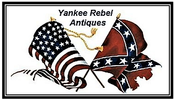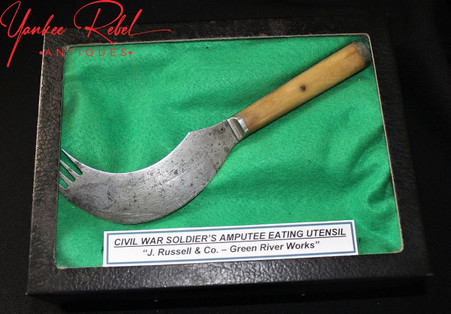 Loading... Please wait...
Loading... Please wait...-
Call us on (973) 810-2976
- My Account
- Gift Certificates
- Items / $0.00
All prices are in All prices are in USD
Categories
- Home
- Sold, Hold, Layaway items
- Civil War soldier’s Amputee Eating Utensil – as in museums (SOLD)
Civil War soldier’s Amputee Eating Utensil – as in museums (SOLD)
Out of Stock
Product Description
This is another unique and rare item offered, it is a Civil War soldier’s Invalid Eating Utensil. It has a bone handle along with a steel blade. It measures approximately 8” long. The design was such that the blade would cut the food by a rocking motion of the blade and then the end would act like a fork to be used for eating. Marked on the blade is “J. Russell & Co. / Green River Works”.
John Russell began manufacturing tools and cutlery in 1834 and established a new factory on the Green River in Massachusetts in 1836. His knives rivaled the quality of those manufactured in Sheffield, England, and as settlers moved West in the 1840s Russell's Green River knives moved with them. His pocket knives were considered the best available by Civil War soldiers. In my book “The Civil War Soldier – His Personal Items”, I show one of his famous pocketknives (see pictures).
Although the exact number is not known, approximately 60,000 surgeries, about three quarters of all the operations performed during the war, were amputations. About 80 percent of the wound’s soldiers received during the Civil War were in the soldier’s arms, hands, legs, and feet. With the shortage of surgeons, it is said "The limbs of soldiers are in as much danger from the ardor of young surgeons as from the missiles of the enemy." In The Civil War Medical Museum in Frederick, Maryland, they have one of these Russell Eating Utensils on display (see pictures). Another is in The Civil War Museum in St. Louis, MO (see pictures).
It was very common for a soldier to lose an arm during the war and such utensils as this one would help them to take care of themselves in the Army hospitals and when they returned home. In my recent book “The Civil War Soldier – His Personal Items”, I have a very similar example shown (see pictures). In the book I write “Although artificial limbs were available, many veterans felt that instead of hiding their injury with prosthesis, they would make their sacrifice visible. The display of an ‘honorable scar’, especially during and immediately after the war, helped amputees to assert their contribution to the cause”.



